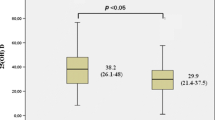Abstract
Objectives
To assess the nutritional and infection status of rural schoolchildren and to study the relationship of infection status with serum 25(OH)D concentrations.
Methods
This study was carried out in a primary school, in a rural setting, near Pune (18°N), Maharashtra. Data collected from 387 children included anthropometric, clinical, infection-related data (using a validated questionnaire) and dietary data (by 24-h recall method over 3 non-consecutive days, including a holiday) and serum 25(OH)D estimations (by ELISA).
Results
Prevalence of underweight and stunting were 18% and 11% respectively. Upper respiratory tract infection (URTI) related symptoms were commonly reported. Episodes of URTI were found to be significantly and negatively correlated with serum 25(OH)D concentrations (rs = −0.14, p < 0.05) and lesser URTI episodes and duration were reported by children who were vitamin D sufficient as compared to those who were insufficient. No association of total infections was found with vitamin D status.
Conclusions
Moderate prevalence of underweight and stunting and frequent URTIs were observed in this population. Higher serum 25(OH)D concentrations and vitamin D sufficiency may be important for prevention of upper respiratory tract infections in rural children.

Similar content being viewed by others

References
De Castro Kroner J, Sommer A, Fabri M. Vitamin D every day to keep the infection away? Nutrients. 2015;7:4170–88.
Harinarayan CV, Ramalakshmi T, Prasad UV, Sudhakar D. Vitamin D status in Andhra Pradesh: a population based study. Indian J Med Res. 2008;127:211–8.
Gredel S. Nutrition and Immunity in Man, 2nd ed. Brussels: International Life Sciences Institute; 2011. p. 1–40.
Mandlik R, Khadilkar A, Kajale N, et al. Response of serum 25(OH)D to vitamin D and calcium supplementation in school-children from a semi-rural setting in India. J Steroid Biochem Mol Biol. 2018;180:35–40.
Kumar N, Shekhar C, Kumar P, Kundu A. Kuppuswamy’s socioeconomic status scale-updating for 2007. Indian J Pediatr. 2007;74:1131–2.
Khadilkar V, Yadav S, Agrawal K, et al. Revised IAP growth charts for height, weight and body mass index for 5-18-year-old Indian children. Indian Pediatr. 2015;52:47–55.
Bruijnzeels MA, Foets M, Van Der Wouden JC, Prins A, Van Den Heuvel WJA. Measuring morbidity of children in the community: a comparison of interview and diary data. Int J Epidemiol. 1998;27:96–100.
Parthasarathy A. IAP Textbook of Pediatrics, 5th ed. New Delhi: Jaypee Brothers Medical Publishers (P) Ltd; 2013. p. 465–6. 492–8, 532, 611–2, 976–1014.
Chiplonkar S. CDiet – BELLYCHEATERS [Internet]. Available at: https://bellycheaters.com/cdiet/. Accessed 5 Oct 2018.
Indian Council of Medical Research. Nutrient Requirements and Recommended Dietary Allowances for Indians. Hyderabad: Expert Group of the Indian Council of Medical Research; 2009. p. 1–334.
Holick MF, Binkley NC, Bischoff-Ferrari HA, et al. Evaluation, treatment, and prevention of vitamin D deficiency: an Endocrine Society Clinical Practice Guideline. J Clin Endocrinol Metab. 2011;96:1911–30.
Rashmi M, Shweta B, Fathima FN, Agrawal T, Shah M, Sequeira R. Prevalence of malnutrition and relationship with scholastic performance among primary and secondary school children in two select private schools in Bangalore rural district (India). Indian J Community Med. 2015;40:97–102.
Maliye C, Deshmukh P, Gupta S, Kaur S, Mehendale A, Garg B. Nutrient intake amongst rural adolescent girls of Wardha. Indian J Community Med. 2010;35:400–2.
Swaminathan S, Edward BS, Kurpad AV. Micronutrient deficiency and cognitive and physical performance in Indian children. Eur J Clin Nutr. 2013;67:467–74.
Chavan R, Kothari S, Zunjarrao K, Chowdhary A. Surveillance of acute respiratory infections in Mumbai during 2011-12. Indian J Med Microbiol. 2015;33:43–50.
Mandlik R, Chiplonkar S, Khadilkar VV, et al. Prevalence of infections among 6-16 years old children attending a semi-rural school in Western Maharashtra, India. Indian J Child Health. 2015;2:182–6.
Kossmann J, Nestel P, Herrera M, El-Amin A, Fawzi W. Undernutrition and childhood infections: a prospective study of childhood infections in relation to growth in the Sudan. Acta Paediatr. 2000;89:1122–8.
Ginde A, Mansbach J, Camargo C. Association between serum 25-hydroxyvitamin D level and upper respiratory tract infection in the third national health and nutrition examination survey. Arch Intern Med. 2009;169:384–90.
Wayse V, Yousafzai A, Mogale K, Filteau S. Association of subclinical vitamin D deficiency with severe acute lower respiratory infection in Indian children under 5 y. Eur J Clin Nutr. 2004;58:563–7.
Acknowledgements
The authors are thankful for the support and help of Veena Ekbote and Sonal Palande. Further, they are grateful to the school principals, teachers and school staff and to all the children and parents who participated in this study.
Author information
Authors and Affiliations
Contributions
RM was responsible for data collection, carried out the analyses and drafted the initial manuscript; SC conceptualized and designed the study, carried out the analyses, reviewed and revised the manuscript, and approved the final manuscript as submitted; NK conducted all the biochemical estimations and assisted with data collection; VK conceptualized and designed the study, critically reviewed the manuscript, and approved the final manuscript as submitted; AK conceptualized and designed the study, supervised data collection, reviewed and revised the manuscript, and approved the final manuscript as submitted. AK is the guarantor for this paper.
Corresponding author
Ethics declarations
Conflict of Interest
None.
Source of Funding
Ms. Rubina Mandlik received a Junior Research Fellowship from the University Grants Commission (UGC), Government of India.
Additional information
Publisher’s Note
Springer Nature remains neutral with regard to jurisdictional claims in published maps and institutional affiliations.
Rights and permissions
About this article
Cite this article
Mandlik, R., Chiplonkar, S., Kajale, N. et al. Infection Status of Rural Schoolchildren and its Relationship with Vitamin D Concentrations. Indian J Pediatr 86, 675–680 (2019). https://doi.org/10.1007/s12098-019-02933-4
Received:
Accepted:
Published:
Issue Date:
DOI: https://doi.org/10.1007/s12098-019-02933-4


